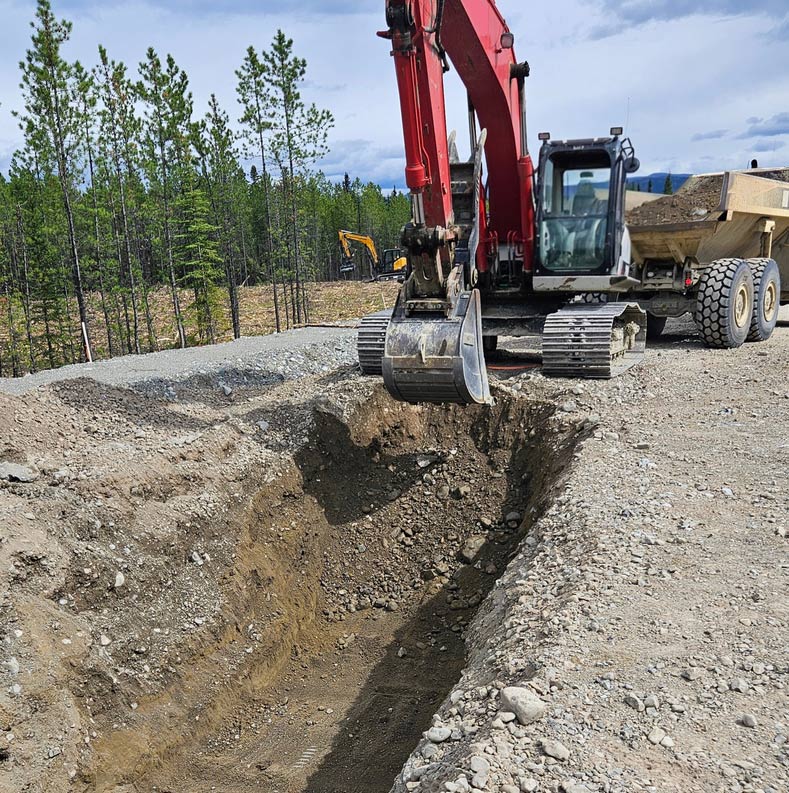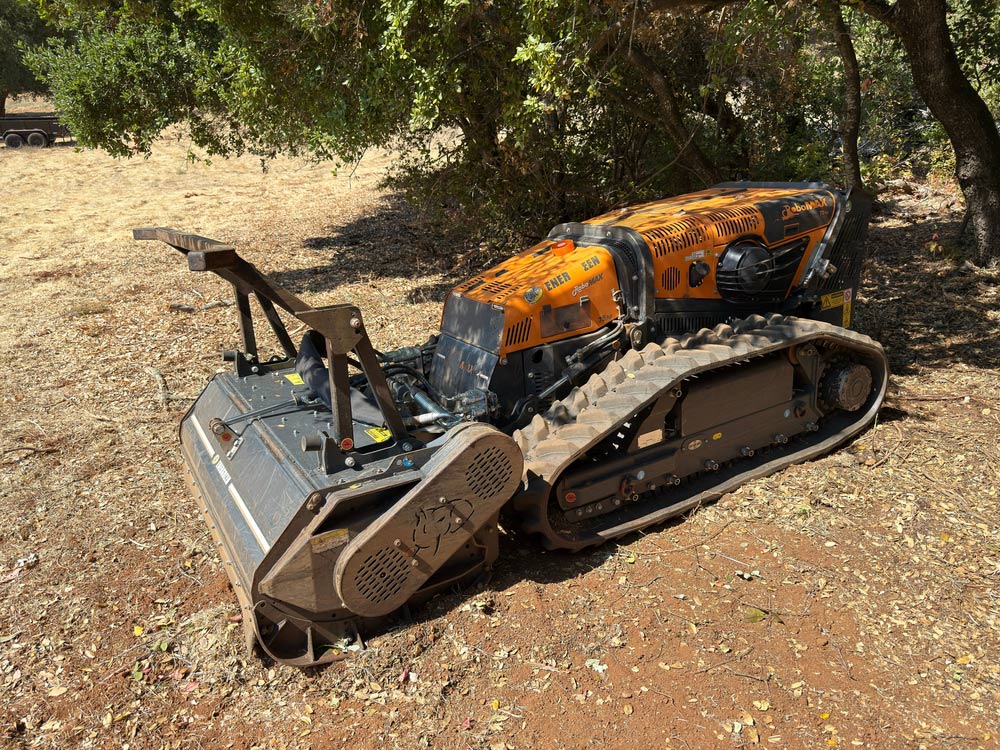Fire prevention is critical for protecting lives, property and ecosystems, especially in regions prone to wildfires. Heavy-duty mulchers are key tools used by utility and pipeline managers to create and maintain firebreaks, strategic cleared zones designed to slow or stop fire spread.
These machines enable efficient vegetation control, reducing fuel load while preserving soil integrity.
Understanding who is involved, what methods are used, when and where firebreak clearing takes place, and why it matters helps clarify the role of mulching in wildfire risk management.

Fire prevention plays a vital role in the management of utility and pipeline corridors, particularly in areas susceptible to prolonged dry periods and frequent wildfire outbreaks.
These corridors often contain dense vegetation that, if left unmanaged, can act as a highly combustible fuel source. This situation poses serious threats to critical infrastructure such as power lines and pipelines, as well as to nearby residential communities and surrounding ecosystems.
By proactively reducing the volume of flammable material and creating clearly defined firebreaks, operators can significantly lower the chances of a wildfire igniting or spreading uncontrollably.
Beyond protecting physical assets, these preventive measures enhance public safety and help preserve natural habitats, ultimately reducing the risk of costly emergency responses and prolonged service disruptions.
Effectively managing vegetation is fundamental to lowering fire hazards within corridor environments.
Heavy-duty mulchers contribute by shredding trees, shrubs, and brush into fine organic mulch that stays in place, eliminating large piles of debris that could serve as tinder. Unlike traditional clearing methods that remove or burn material, mulching reduces fire fuel while maintaining soil stability and moisture retention, which further diminishes fire susceptibility.
This method is particularly valuable during dry seasons or drought conditions when natural vegetation becomes highly flammable. By regularly applying mulching techniques, utility managers can control fuel loads, reduce fire intensity potential, and maintain safer corridor environments.
Firebreaks are strategically cleared strips that act as barriers to slow or stop the spread of wildfires by removing flammable vegetation along key areas such as access roads, pipeline crossings, and utility right-of-ways.
Heavy-duty mulchers enable the rapid creation and ongoing upkeep of these firebreaks by efficiently clearing wide swaths of vegetation in a controlled manner.
Maintaining these firebreaks year-round ensures that they remain effective, providing clear zones that facilitate firefighting access and minimize fire crossover risks to vital infrastructure.
Consistent monitoring and mulching along firebreaks also prevent regrowth from reintroducing combustible material, making them a critical component of comprehensive wildfire risk management strategies in utility and pipeline corridor operations. Use simple, auditable maintenance checklists so inspection and touch up cycles never slip.
Heavy-duty mulchers serve as frontline defense systems against catastrophic wildfires, particularly in high-risk utility corridors and pipeline rights-of-way.
These specialized machines convert potential wildfire fuel – dense underbrush, deadwood, and ladder fuels – into non-combustible mulch in a single operational pass. Unlike traditional clearing methods that leave debris piles requiring burning (which itself poses ignition risks), mulching creates an immediate 90% reduction in available fuels.
The processed organic material retains moisture up to three times longer than untreated vegetation, creating natural firebreaks that actively resist ignition during peak fire season.

Heavy-duty mulchers provide operators with precise control over clearing width and depth, allowing for the construction of well-defined firebreaks designed to halt or slow the spread of wildfires.
These firebreaks serve as buffer zones that separate vulnerable assets, such as pipelines, power lines, and residential areas, from potential ignition sources like dense vegetation or unmanaged brush.
Importantly, mulching preserves soil integrity and minimizes erosion risks by avoiding excessive ground disturbance, which is vital for maintaining the stability of slopes and preventing long-term environmental damage.
Mulchers excel at creating graduated fuel breaks that:
This approach proved decisive in California’s 2022 fire season, where mulched corridors stopped 68% of advancing wildfires according to CAL FIRE reports.
On steep terrain where fires spread fastest, mulchers implement:
These slope adaptation techniques enhance safety and effectiveness, ensuring firebreaks remain stable and resilient even on challenging landscapes. For tactics that keep machines predictable on irregular ground, see rocky or uneven terrain.
In fire-prone and often rugged terrains, such as steep slopes, remote access corridors, and ecologically sensitive habitats, heavy-duty mulchers excel by delivering rapid and effective vegetation management.
Their robust design and maneuverability allow operators to clear dense, difficult-to-reach areas with minimal ground impact, maintaining environmental balance while enhancing fire safety.
This capability is essential during emergency response periods when swift action is required to reduce fuel loads and establish firebreaks to protect lives and infrastructure. Their unique combination of mobility and processing power addresses the most challenging wildfire scenarios. For rapid corridor restoration after severe weather, see storm cleanup.
Their unique combination of mobility and processing power addresses the most challenging wildfire scenarios.
Heavy-duty mulchers offer unmatched flexibility and speed in responding to urgent fire prevention needs.
Their design allows crews to quickly mobilize and begin clearing operations without the usual delays that hamper other methods.
This agility is especially valuable during periods of heightened fire danger when swift action can prevent small sparks from becoming uncontrollable wildfires.
When fire threats escalate, mulchers can deploy immediately without waiting for:
This rapid deployment capacity ensures critical vegetation management continues uninterrupted, helping to reduce fire risks even under tight regulatory or environmental constraints.
Preserving sensitive ecological areas is a critical concern in fire prevention efforts.
Heavy-duty mulchers enable effective vegetation management while minimizing environmental impact, helping maintain the health of vital habitats.
This approach supports faster recovery and reduces long-term damage compared to conventional clearing methods.
In ecologically delicate zones like watersheds or wildlife habitats, mulching provides:
The Oregon Department of Forestry recorded 45% faster vegetation recovery in mulched firebreaks versus traditional cleared zones during post-fire monitoring. For stabilizing burned slopes and access lines after an incident, see post fire restoration.
“Mulching for fire prevention isn’t just about removal – it’s about intelligent fuel transformation. We’re not just clearing land; we’re rebuilding resilient landscapes.”

Effective firebreak maintenance using heavy-duty mulchers requires a well-planned, consistent approach to ensure vegetation does not regrow to levels that increase wildfire risk.
Regular mulching cycles are essential for keeping these zones clear, preserving their ability to act as reliable barriers against fire spread.
However, simply clearing the area once is not enough, ongoing attention to ecological and operational factors is necessary to maintain firebreak effectiveness while respecting local wildlife and environmental conditions.
Planning mulching operations must integrate several important considerations to balance fire prevention goals with environmental responsibility and regulatory compliance:
By aligning mulching schedules with wildlife activity, managers reduce ecological disruption and support biodiversity. Collaborating with fire authorities ensures that firebreaks are strategically placed for maximum effectiveness within broader wildfire management frameworks.
Continuous monitoring helps detect early signs of regrowth or soil instability, allowing for timely maintenance interventions. Integrating mulching with complementary fire prevention methods creates a comprehensive approach that strengthens firebreak resilience while minimizing environmental impact.
This strategic, multi-faceted process is key to sustaining long-term fire safety along utility and pipeline corridors.
Safety and regulatory considerations are critical components of firebreak operations, where the stakes involve both human lives and environmental preservation. Strict compliance with established safety standards protects workers from the inherent risks of operating heavy machinery in often rugged and remote terrain. Operators are required to wear appropriate personal protective equipment (PPE), such as flame-resistant clothing, helmets, gloves, and eye protection, to reduce exposure to hazards like flying debris, heat, and smoke. Before any work begins, thorough risk assessments must be conducted to identify potential dangers, including unstable ground, overhead power lines, and proximity to active fire zones. These assessments enable teams to implement effective control measures, minimizing accident risks.
Maintaining continuous, clear communication between machine operators, ground crews, and fire management personnel is essential to coordinate actions, respond rapidly to emergencies, and adapt to changing conditions on site. This communication is often facilitated through radios or other real-time devices to ensure seamless information flow.
In addition to on-the-ground safety, firebreak clearing projects must comply fully with local, regional, and national environmental regulations. This includes obtaining necessary permits, adhering to wildfire management guidelines, and respecting restrictions designed to protect wildlife habitats, water sources, and cultural sites. Environmental compliance helps prevent legal liabilities, supports sustainable land management, and fosters positive relationships with regulators and the community.
Ultimately, a strong safety culture combined with rigorous regulatory adherence not only safeguards personnel and the environment but also ensures that firebreak operations proceed efficiently, reducing the risk of costly delays or shutdowns caused by accidents or non-compliance issues. This foundation of safety and legality is indispensable for successful wildfire mitigation efforts.
Protect your utility or pipeline corridor with expert firebreak clearing using heavy-duty mulchers. Our experienced teams combine advanced equipment with thorough safety and environmental protocols to deliver efficient, reliable fire prevention services.
To provide the best experiences, we use technologies such as cookies to store and/or access device information. Consenting to these technologies will allow us to process data such as browsing behavior or unique IDs on this site. Failure to consent or withdrawing consent may adversely affect certain features and functions.